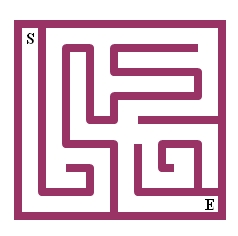CMSC 202 - Project 3
Pointing out a Maze Solver

| Assigned | Sunday April 2, 2006 |
| Design Due | Saturday April 8, 2006 at 11:59 pm |
| Program Due | Sunday April 16, 2006 at 11:59pm |
| Updates |
|

| Assigned | Sunday April 2, 2006 |
| Design Due | Saturday April 8, 2006 at 11:59 pm |
| Program Due | Sunday April 16, 2006 at 11:59pm |
| Updates |
|
As an employee of Childrens' Games, Inc., you have been tasked with the responsibility of demonstrating that all of the mazes that have been generated for the new Maze & Puzzle book are indeed solvable. Fortunately, another developer has created an application that generates "perfect" mazes (perfect mazes have exactly one path from start to finish, thus having no loops). It is your responsibility to double-check each maze that the application generated so that children around the world will have brighter lives when they receive the Maze & Puzzle book as a gift.
You must implement the Big Three (Destructor, Copy-Constructor and Assignment operator) for each of these classes.
You are also required to modify the MazeCell class to use pointers to its neighbors to determine which directions are open. You will also need to make modifications to the Maze and/or MazeCrawler classes to support this new connection between MazeCells.
You are also required to overload the extraction operator for the Maze class. Again, feel free to reuse any existing code. Do not duplicate code. You may choose to delete any existing methods that accomplish the same task. The stream passed into the extraction operator should be an open file.
All overloaded operators must operate on OBJECTS of each class, NOT on pointers to an object. You should remember to dereference pointers before attempting to use the overloaded operators on them.
Each of these classes must have the Big Three implemented and used appropriately. All instances of dynamic memory in these classes should be properly allocated and deallocated in the Big Three. Even if your class does not allocate dynamic memory, you must overload the Big Three.
The purpose of this optimization is to speed up the time it takes to compute which direction to travel. It also eliminates the need for row and column computations when finding a neighbor during each decision of next direction.
When attempting to determine which direction to move from the current cell, your MazeCrawler can examine each of the neighbors by accessing them via pointers. Then, once it makes a decision, it can simply follow that pointer to move to the neighboring cell. This moves our application one more step toward low-coupling, allowing our MazeCrawler to have absolutely NO knowledge of the internal representation of the Maze - all it needs is a pointer to the current cell!
Depending on your current implementation, you may or may not need to make changes to the Maze class as well as the MazeCrawler when modifying your MazeCell class to support these dynamic links. Ideally, after implementing dynamic links, your application could support Mazes of arbitrary shape and size.
You are also required to implement the extraction operator for the Maze class. The extraction operator should accept a stream, and read the maze from that stream. If the stream passed is a file stream, the file should already have been successfully opened.
The "make" utility is used to help control projects with large numbers of files. It consists of targets, rules, and dependencies. You will be learning about make files in lab. For this project, the makefile will be provided for you. You will be responsible for providing makefiles for all future projects. Copy the file makefile from Ms. Wortman's public directory to your directory.
When you want to compile and link your program, simply type the command make or make Proj3 at the Linux prompt. This will compile all necessary .cpp files and create the executable named Proj3.
The make utility can also be used for compiling a single file without linking. For example, to compile Proj3.cpp, type make Proj3.o.
In addition to compiling and linking your files, make can be used for maintaining your directory. Typing make clean will remove any extraneous files in your directory, such as .o files and core files. Typing make cleanest will remove all .o files, core files, Proj3 executable and backup files created by the editor. More information about these commands can be found at the bottom of the makefile.
Updated: If you are building your own makefile, you MUST use the /usr/local/bin/g++ compiler to compile and build each file. Do not depend on setting your default compiler to be this compiler, the grader may use a different compiler. There are two compilers on the GL systems, and you are required to use the one located at /usr/local/bin/g++.
The grade for this project will be broken down as follows. A more detailed breakdown will be provided in the grade form you receive with your project grade.
You can check to see what files you have submitted by typing
Be sure to build your project once it has been submitted using the submitmake command, so that you know that all of the files are there and are the most up-to-date versions:
Test your program to ensure that all files are the most recent versions:
Remember -- if you make any change to your program, no matter how insignificant it may seem, you should recompile and retest your program before submitting it. Even the smallest typo can cause compiler errors and a reduction in your grade.
Avoid unpleasant surprises!
Be sure to use the submitmake and submitrun utilities provided for you to compile, link and run your program after you've submitted it.